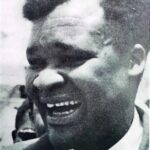PRETORIUS, ANDRIES WILHELMUS JACOBUS
- 6 Min Read
Andries Wilhelmus Jacobus Pretorius (November 27, 1798-July 23, 1853), voortrekker leader and hero of the battle of Blood River, was the eldest of the five children of Marthinus Wessel Pretorius and his wife Susanna Elizabeth Viljoen. He spent the first 40 years of his life in the vicinity of Graaff-Reinet where he was a respected farmer at the time when the Great Trek started.

PHOTO CAPTION: Pretorius Andries Wilhelmus Jacobus. SOURCE: EA Library.
In October 1838, he left Graaff-Reinet to join the Voortrekkers in Natal and, a few days after his arrival in the camp on the bank of the Little Tugela, he was elected head commandant of the punitive commando against the Zulu. The commando of 470 men and approximately 60 wagons had been travelling for several days when a covenant was proclaimed at a place now known as Wasbankspruit.
It was to the effect that, if God granted them the victory, they would build a church to His name and they and their descendants would celebrate the anniversary of the deliverance as a day of thanksgiving. On December 15, 1838, Pretorius received a report that the Zulu army was approaching. He thereupon ordered the wagons to be drawn in a circle near a river now known as Blood River.
The Zulu army of about 10,000 men attacked the lager soon after first light on Sunday, December 16, 1838. Pretorius and his men, however, repelled the attack, and when the Zulu took flight after two hours, they left more than 3,000 dead on the battlefield. On the side of the Voortrekkers were only three wounded, one of whom was Pretorius.
Taking into account the great losses by the Zulu, the battle of Blood River is the biggest single battle ever fought on South African soil. It is also considered one of the most glorious victories in the military history of the Afrikaners. Pretorius proved himself to be a brilliant strategist and, almost overnight, he became famous as the hero of Blood River.
Pretorius and his commando thereupon advanced to the Zulu capital, Umgungundlovu, but found the place deserted and in flames. The Zulu king Dingane and his people had fled into the almost inaccessible ravines of the White Umfolozi.
The remains of Piet Retief and his men, who were murdered by Dingane some ten months before, were found on a hill near the Zulu capital. It is said that in Retiefs satchel was found the Dingane-Retief land concession.
After the return of the commando, Pretorius settled on a farm near Pietermaritzburg. In May 1839, he concluded peace with representatives of Dingane, but when it became clear that the Zulu king had no intention of complying with the terms of the treaty, the Volksraad ordered Pretorius to take 40,000 cattle from the Zulu by force. Pretorius left with his commando for Zululand after having arranged with the Zulu chief Mpande that his army would attack Dingane from the southeast.
Mpande had broken with Dingane late in 1839, taking thousands of men south of the Tungela River with him. While Mpande saw himself as a friend of, and co-conspirator with, the Boer, they saw him as their vassal. When Pretorius reached the Black Umfolozi, he received the news that Mpande’s army had defeated Dingane’s army two days before in the Magongo hills. A few days later, Pretorius crowned Mpande King of the Zulu, and issued a proclamation annexing the territory between the Tugela and the Black Umfolozi.
Following his return, Pretorius was both a member of the Volksraad and commandant-general of the Natal Voortrekkers. He resigned the latter position in early 1842, but was asked to accept it again shortly thereafter. When a British force under Captain T.C. Smith reoccupied Port Natal in May 1842, Pretorius was allotted the task of persuading the British to leave. Smith, however, refused and decided to carry out a surprise attack on Pretorius’s camp at Congella. Pretorius was prepared for this and greeted Smith’s troops with gunfire; they fled almost immediately.
The British lost approximately 20 men, while one of Pretorius’s men was killed. Pretorius then besieged Smith in his camp and it was only after the arrival of Lt.-Col. A.J. Cloete’s force a month later that Smith was relieved. Pretorius realised that further resistance to the British occupation of Port Natal was useless and the Volksraad submitted to British authority.
When a substantial group of Voortrekkers left Natal in 1843, Pretorius decided to stay, hoping that he could successfully cooperate with the British authorities. This was, however, impossible. The British policy in regard to land and African settlement caused such dissatisfaction that Pretorius travelled to Grahamstown to put his complaints before the Governor of the Cape Colony. The Governor, Sir Henry Pottinger, refused to see him. Pretorius returned to Natal, embittered towards the British and convinced that British rule should be resisted with the gun.
While Pretorius was preparing for war, the new Governor of the Cape Colony, Sir Harry Smith, made his appearance at the Voortrekkers’ camp on the Tugela. In the controversial discussion which took place, Smith informed Pretorius that the area north of the Orange River was to be annexed as British territory. Pretorius told Smith that his compatriots wanted independence and that annexation would lead to further emigration or to rebellion.
In June 1848, Pretorius received an urgent request from the Boers of Winburg to lead them in their resistance to the British magistrate who had been appointed over them. Pretorius responded to their call, and he forced the British magistrate to evacuate the town. This act of rebellion led to the battle of Boomplaats (August 29, 1848) where Pretorius’s force was defeated by a British force under the command of Sir Harry Smith.
Pretorius’s defeat at Boomplaats was a blow to his prestige as a leader, but not decisive. He continued to play a leading part in the affairs of state north of the Vaal River. He started negotiations with the British authorities for a better understanding, and these led to the Sand River Convention of January 17, 1852. With this agreement, Pretorius obtained for the Voortrekkers that which they had striven for in vain since the beginning of the Great Trek, an independent state of their own, recognised by the British government.
On July 23, 1853, Pretorius died at the age of 54 on his farm, Grootplaats, near the present Hartbeespoortdam. He was buried at Grootplaats, but, on May 13, 1891, his remains were reinterred with great ceremony in the Old Cemetery in Pretoria.
Pretorius’s claim to a place in the front line of South Africa’s historical figures is based on his achievements as a soldier and a statesman. The battle of Blood River and his many subsequent conflicts with both African and British perpetuated his memory as a soldier. The Sand River Convention crowned his efforts for the political independence of the Afrikaners.
B. J. LIEBENBERG





